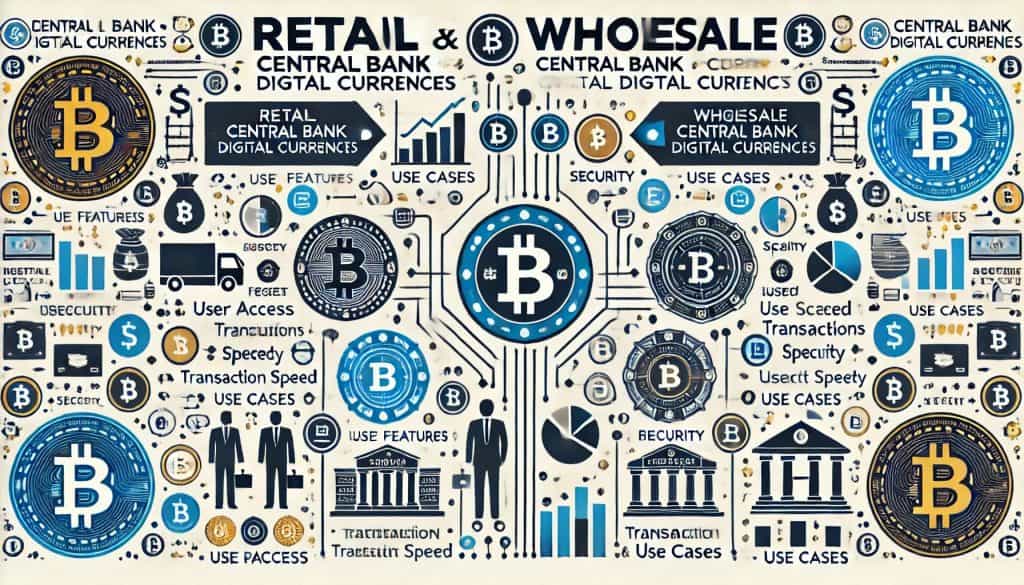The evolution of money has undergone a significant shift from barter systems, to physical money, and now to digital money. Central bank digital currencies (CBDCs) represent the next step in this evolution. In essence, CBDCs are digital versions of a country’s fiat currency, issued and regulated by the country’s central bank. Unlike cryptocurrencies like Bitcoin, which operate on a decentralized network, CBDCs are centralized and maintain the stability of a country’s currency.

CBDCs aim to combine the benefits of digital payment systems with the trust and security of traditional central banks. They promise improved efficiency, transparency, and financial inclusion. However, the implementation of CBDCs is not without its challenges. Issues related to privacy, security, and the potential disruption of existing financial systems require careful consideration.
What is a central bank digital currency (CBDC)?
Central bank digital currency (CBDC) is a digital form of fiat currency issued by a country’s central bank. It’s a fiat currency similar to physical cash, but only exists in electronic form. CBDCs are designed to be used in everyday transactions, similar to the way cash is used today, but with the added benefit of digital payments.
Key Features of CBDCs
- Centralized issuance: Unlike decentralized cryptocurrencies, CBDCs are issued and regulated by a central bank.
- Legal tender: CBDC is recognized by governments as a valid form of money and can be used for all types of transactions.
- Digital nature: Fully digitalized CBDCs can be easily transferred between parties, allowing for faster and more efficient payments.
Types of CBDCs
CBDCs can be categorized into two main types
- Retail CBDC: Designed for use by the general public and can be used for everyday transactions.
- Wholesale CBDC: Intended for use by financial institutions, primarily used for interbank transfers and large transactions.

Retail vs. wholesale CBDCs
| Features | Retail CBDCs | Wholesale CBDC |
|---|---|---|
| User | General public | Financial institutions |
| Transaction size | Small business transactions | Large interbank transactions |
| Accessibility | Highly accessible, broadly accessible | Financial institutions only |
| Purpose | Everyday payments, including finance | Large-scale trade settlement, liquidity management |
| Security | Emphasize privacy and user protection | Emphasize efficiency and transaction speed |
Benefits of CBDCs
CBDCs offer several potential benefits that could change the financial landscape.
Strengthening financial inclusion
One of the most important benefits of CBDCs is their potential to improve financial inclusion. By providing digital payment methods that don’t require a traditional bank account, CBDCs can help bring financial services to unbanked and underbanked populations.
Increase efficiency and reduce costs
CBDCs can streamline payment systems, reducing the cost of printing and processing physical cash. They can also facilitate faster and more secure transactions, both domestically and internationally.
Improving monetary policy implementation
CBDCs provide central banks with new tools to implement monetary policy. By directly controlling the digital money supply, central banks can better manage inflation, interest rates, and overall economic stability.
Enhanced security and fraud prevention
Designers can equip digital currencies with advanced security features to prevent counterfeiting and reduce the risk of fraud. They can also provide better transaction traceability, which can help prevent money laundering and other illegal activities.
Benefits of CBDCs
| Benefits | Description |
|---|---|
| Financial inclusion | Expanding access to financial services for unbanked and underbanked populations |
| Efficiency and cost savings | Simplify payment systems, reduce costs associated with cash management |
| Monetary policy | Give central banks better tools to manage their economies |
| Security and fraud prevention | Enhance security, increase traceability, and reduce fraud risk |
Potential risks and challenges of CBDCs

CBDCs hold great promise, but they also present some risks and challenges that require attention.
| Risks/Challenges | Description |
|---|---|
| Privacy | Potential for increased security surveillance and data privacy concerns |
| Cybersecurity | Vulnerability to hacking and other cyber threats |
| Financial system collapse | Impact on incumbent banks and the existing financial system |
| Implementation costs | Significant investment in technology and infrastructure development |
The global landscape of CBDCs
Countries around the world are in various stages of exploring and implementing CBDCs. Some countries are conducting research and pilot programs, while others have already launched digital currencies.
Case study: China’s digital yuan
China is one of the frontrunners in the CBDC race. The People’s Bank of China (PBOC) has been working on the digital yuan (e-CNY) for years and has conducted extensive pilot programs in various cities. The digital yuan aims to improve payment efficiency, reduce fraud, and support financial inclusion.
Case Study: The European Central Bank and the digital euro
The European Central Bank is exploring the possibilities of a digital euro. The European Central Bank aims for the digital euro to complement cash, enhance payment efficiency, and support the stability of the financial system. The project remains in the research and development phase, with a decision on implementation expected in the coming years.
To better understand the concept and implications of central bank digital currencies, watch a video that provides an insightful overview:
| Country | CBDC status | Key features and goals |
|---|---|---|
| China | Pilot program | Improve payment efficiency, reduce fraud, and support financial inclusion |
| European Union | R&D | Complement cash, increase payment efficiency, and support financial system stability |
| United States | Investigations | Explore potential benefits and harms |
| Bahamas | Release (Sand Dollar) | Increase financial inclusion, modernize payment systems |
| Sweden | Pilot Program (e-Krona) | Reduce cash dependency, improve payment efficiency |
Conclusion
Central bank digital currencies (CBDCs) represent an important innovation in the financial world, with the potential to increase financial inclusion, increase efficiency, and improve monetary policy implementation. However, they also raise issues related to privacy, cybersecurity, and potential disruption of existing financial systems. To ensure successful integration of Central Bank Digital Currencies (CBDCs) into the global economy, countries must actively address key issues as they explore and implement these digital currencies.
FAQ
What is CBDC?
A central bank digital currency (CBDC) is a digital form of a country’s fiat currency that is issued and regulated by a central bank.
What are the benefits of CBDCs?
Increased financial inclusion, greater efficiency, improved monetary policy, and greater security.
Which countries are leading the way in CBDC development?
Privacy concerns, cybersecurity risks, financial system disruption, and high implementation costs.
References
- Investopedia. (n.d.). Central Bank Digital Currency (CBDC).
- TechTarget. (n.d.). Central bank digital currencies (CBDCs).
- World Economic Forum. (2023). What is a central bank digital currency?
- Britannica. Central Bank Digital Currency (CBDC).
- McKinsey. What is a Central Bank Digital Currency (CBDC)?
